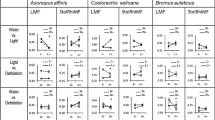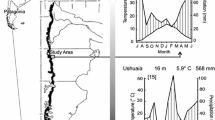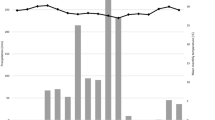Abstract
Grasses are becoming more abundant in areas in NE Scotland which until recently were dominated by heather (Calluna vulgaris). However, it is not clear if grasses are aggressive competitors which are now able to outcompete the dwarf shrub due to changes in environmental factors (such as grazing pressure and increasing nutrient inputs), or just opportunistic invaders, occupying gaps in the canopy which occur when heather reaches the degenerate stage. Experiments in turves and in field plots were carried out in order to investigate the performance of three grass species, Nardus stricta, Deschampsia cespitosa and Deschampsia flexuosa growing in competition with heather. These three species were selected because they differ in their nutrient requirements, palatability to herbivores and tolerance of shading. The grasses were planted in heather canopies of different structure, either turves of heather of different height and age, or moorland plots with or without heavy grazing by sheep and deer. Fertiliser (NPK) was applied to half the experimental plants. The growth of the grass species and the heather in response to the fertiliser and grazing treatments was measured, together with the light levels penetrating the canopy and received by the grass plants.
Results indicated that heather was likely to be outcompeted by grasses only when there are gaps in the canopy, resulting either from heavy grazing or from the heather being in the mature or degenerate phase. Fertiliser enhanced plant growth whereas fencing out herbivores led to strong competition for light as the heather canopy closed. It is concluded that grasses require gaps in the canopy to successfully invade heather moorland, or they tend to be shaded out. Thus better management of heather moorlands to maintain a dense canopy structure may help to preserve heather cover even under increasing nutrient inputs.
Similar content being viewed by others
References
Aerts, R. 1993a. Biomass and nutrient dynamics of dominant plant species from heathlands. Pp. 51-84. In: Aerts, R. & Heil, G. W. (eds), Heathlands: Patterns and Processes in a Changing Environment. Kluwer Academic Publishers, Dordrecht, The Netherlands.
Aerts, R. 1993b. Competition between dominant plant species in heathlands. Pp. 125-151. In: Aerts, R. & Heil, G.W. (eds), Heathlands: Patterns and Processes in a Changing Environment. Kluwer Academic Publishers, Dordrecht, The Netherlands.
Aerts, R. & Berendse, F. 1989. Above-ground nutrient turnover and net primary production of an evergreen and a deciduous species in a heathland ecosystem. J. Ecol. 77: 343-356.
Aerts, R., Berendse, F., de Caluwe, H. & Schmitz, M. 1990. Competition in heathland along an experimental gradient of nutrient availability. Oikos 57: 310-318.
Anderson, P. & Yalden, D. W. 1981. Increased sheep numbers and the loss of heather moorland in the Peak District, England. Biol. Cons. 20: 195-213.
Berendse, F. 1985. The effect of grazing on the outcome of competition between plant species with different nutrient requirements. Oikos 44: 35-39.
Bryant, J. P., Chapin, F. S. & Klein, D. R. 1983. Carbon/nutrient balance of boreal plants in relation to vertebrate herbivory. Oikos 40: 357-368.
Caporn, S., Davison, A., Fowler, D., Harriman, R., Hornung, M., McNeill, S. & van der Eerden, L. 1994. The ecological effects of increased aerial deposition of nitrogen. Field Studies Council for The British Ecological Society, Shrewsbury.
Chapi, F. S. III and Shaver, G. R. 1985. Individualistic growth responses of tundra plant species to environmental manipulations in the field. Ecology 66: 564-576.
Coley, P. D., Bryant, J. P. & Chapin, F. S. 1985. Resource availability and plant antiherbivore defense. Science 230: 895-899.
de Smidt, J. T. 1995. The imminent destruction of northwest European heaths due to atmospheric nitrogen deposition. Pp. 206- 217. In: Thompson, D. B. A., Hester, A. & User, M. B. (eds), Heaths and Moorlands. Cultural Landscapes. SNH, Edinburgh.
Duncan, A. J., Hartley, S. E. & Iason, G. R. 1994. Fine-scale discrimination of forage quality by sheep offered a soybean meal or barley supplement while grazing a nitrogen-fertilized heather (Calluna vulgaris) mosaic. J. Agric. Sci. 123: 363-370.
Eissenstat, D. M. & Caldwell, M. M. 1987. Characteristics of successful competitors: an evaluation of potential growth rate in two cold desert tussock grasses. Oecologia 71: 167–173.
Gimingham, C. H. 1972. Ecology of Heathlands. Chapman and Hall, London.
Grime, J. P. 1979. Plant strategies and vegetation processes. Wiley, Chichester.
Grime, J. P., Hodgson, J. G., Hunt, R. 1988. Comparative plant ecology. A functional approach to common British species. Unwin Hyman. London.
Hartley, S. E. 1995. Vegetation dynamics in the Scottish Uplands: Mechanisms and consequences of changes in the grass/heather competitive balance. Second year report to the Royal Weir Foundation Research Fellowship in Environmental Science. ITE Banchory.
Hartley, S. E. 1997. The effects of grazing and nutrient inputs on grass-heather competition. Bot. J. Scotland 49: 315-324.
Hartley, S. E., Nelson, K. & Gorman, M. 1995. The effect of fertiliser and shading on plant chemical composition and palatability to Orkney voles, Microtus arvalis orcadensis. Oikos 72: 79-87.
Heil, G. W. & Aerts, R. 1993. General introduction. Pp. 1- 24. In: Aerts, R. & Heil, G. W. (eds), Heathlands: Patterns and Processes in a Changing Environment. Kluwer Academic Publishers, Dordrecht, The Netherlands.
Heil, G. W. & Bruggink, M. 1987. Competition for nutrients between Calluna vulgaris(L.) Hull and Molinia caerulea(L.) Moench. Oecologia 73: 105-108.
Heil, G. W. & Diemont, W. H. 1983. Raised nutrient levels change heathland into grassland. Vegetatio 53: 113-120.
Hester, A. J. 1987. Successional vegetation change: the effect of shading on Calluna vulgaris(L.) Hull. Transactions Bot. Soc. Edinburgh 45: 121-126.
Iason, G. R. & Hester, A. J. 1993. The response of heather (Calluna vulgaris) to shade and nutrients - predictions of the carbon-nutrient balance hypothesis. J. Ecol. 81: 75-80.
Iason, G. R., Hartley, S. E. & Duncan, A. J. 1993. Chemical composition of Calluna vulgaris(Ericaceae): do responses to fertilizer vary with phenological stage? Biochem. Syst. Ecol. 21(3): 315-321.
Louda, S. M., Keeker, K. H. & Holt, R. D. 1990. Herbivores influences on plant performance and competitive interactions. Pp. 413-444. In: Grace, J. B. & Tilman, D. (eds). Perspectives on Plant Competition. Academic Press Inc, San Diego.
Miller, G. R. 1968. Evidence for selective feeding on fertilized plots by red grouse, hares and rabbits. J.Wildlife Manag. 32: 849-853.
National Countryside Monitoring Scheme, Scotland: Grampian. 1988. Nature Conservancy Council and Countryside Commission for Scotland, Coupar Angus, Scotland.
Newman, E. I. 1973. Competition and diversity in herbaceous vegetation. Nature 244: 310.
Nolan, A. J. & Robertson, J. S. 1987. Regional trends in dry and moist Scottish moorland vegetation in relation to climate, soils and other ecological factors. J. Ecol. 75: 1145-1157.
Pitcairn, C. E. R., Fowler, D. & Grace, J. 1995. Deposition of fixed atmospheric nitrogen and foliar nitrogen content of bryophytes and Calluna vulgaris(L.) Hull. Env. Pollut. 88: 193-205.
Prins, A. H., Berdowski, J. J. M. & Latuhihin, M. J. 1991. Effect of NH4 fertilization on the maintenance of a Calluna vulgarisvegetation. Acta Bot. Neerlandica 40(4): 269-279.
Sydes, C. 1988. Recent assessments of moorland losses in Scotland. Nature Conservancy Council, Edinburgh.
Tilman, D. 1985. The resource ratio hypothesis of plant succession. Am. Nat. 125: 827-852.
Thompson, D. B. A., MacDonald A. J., Marsden, J. H. & Galbraith, C. A. 1995. Upland heather moorland in Great Britain: a review of international importance, vegetation change and some objectives for nature conservation. Biol. Cons. 71: 163-178.
Tudor, G. J., Mackey, E. C. and Underwood F. M. 1994. The National Countryside Monitoring Scheme. Main Report. SNH, Edinburgh.
Watt, A. S. 1955. Bracken versus heather, a study in plant sociology. J. Ecol. 43: 490-506.
Welch, D. 1986. Studies on the grazing of heather moorland in north-east Scotland. V. Trends in Nardus strictaand other unpalatable graminoids. J. Applied Ecol. 23: 1047-1058.
Welch, D. & Scott, D. 1995. Studies in the grazing of heather moorland in north-east Scotland. VI. 20-year trends in botanical composition. J. Appl. Ecol. 32: 596-611.
Welch, D., Hartley, S. E., Scott, D. & Buse, A. 1995-1996. Long term effects of grazing on upland habitats. Institute of terrestrial Ecology. Annual Report: 26-28.
Author information
Authors and Affiliations
Rights and permissions
About this article
Cite this article
Alonso, I., Hartley, S.E. Effects of nutrient supply, light availability and herbivory on the growth of heather and three competing grass species. Plant Ecology 137, 203–212 (1998). https://doi.org/10.1023/A:1009770313618
Issue Date:
DOI: https://doi.org/10.1023/A:1009770313618




